Speakers revealed for 10th NA Symposium
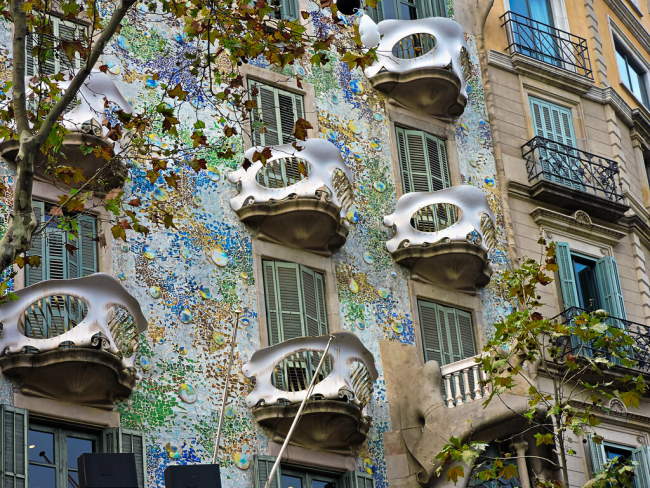
Anticipation is building for Barcelona and our tenth symposium on neuroacanthocytosis on 25-27 March 2020. The combination of scientists and patients will again be organised to share new knowledge since our last meeting in Dresden in 2018 plus bring together new and previous attendees to meet and enlarge the family of NA Advocacy.
 Anticipation is building for Barcelona and our tenth symposium on neuroacanthocytosis on 25-27 March 2020. The combination of scientists and patients will again be organised to share new knowledge since our last meeting in Dresden in 2018 plus bring together new and previous attendees to meet and enlarge the family of NA Advocacy. Anticipation is building for Barcelona and our tenth symposium on neuroacanthocytosis on 25-27 March 2020. The combination of scientists and patients will again be organised to share new knowledge since our last meeting in Dresden in 2018 plus bring together new and previous attendees to meet and enlarge the family of NA Advocacy.
Scientists and their topics will include Adrian Danek and Ruth Walker to present a clinical overview and answer medical queries; Gabriel Miltenberger (PT), C. Paisan-Ruiz (USA) and B. Vande Warrenburg (NL) to discuss VPS13 genes in Movement Disorders; E. Conibear (CA), P. DeCamilli (USA), R. Jahn (DE), Ody Sibon (NL), Ricardo Escalante (ES) and Robert Fuller (USA) will talk about VSP13 proteins in cell processes; Giel Bosman (NL), Lucia De Franceschi (IT), F. Lang (DE), Manuel Jose Rodriguez (ES), L Duplomb (FR) and Teresa Zoladek (PL) are looking at VSP13 proteins in health and disease.
Patients and caregivers will have an opportunity to hear from Symposium organiser Jordi Alberch, JL Lopez- Sendon (ES), Andreas Hermann (DE), and others about the collected efforts of a global panel of speakers. They will also attend their own sessions to address patient and carer issues. Click below for more information and updates on our Facebook page.

 |
|
 |  |
Holiday greetings and thanks from the NA Advocacy
 To all our supporters, we at the Advocacy wish to express our deepest gratitude for the generosity that you have shown over the years. Your donations are indispensable in supporting efforts to raise awareness about neuroacanthocytosis, advance scientific research for answers to this highly impactful group of rare diseases and assure the sustainability of the charity. To all our supporters, we at the Advocacy wish to express our deepest gratitude for the generosity that you have shown over the years. Your donations are indispensable in supporting efforts to raise awareness about neuroacanthocytosis, advance scientific research for answers to this highly impactful group of rare diseases and assure the sustainability of the charity.
2019 has been a special year for the Advocacy. Thanks to your donations and the gift of Carl and Betty Pforzheimer, we are able to announce the first winner of the Glenn Irvine Prize as well as move forward with the funding of research for critical VPS13A genetic mutations, the chorein Western Blot service and the NA database.
To all our supporters, we at the Advocacy wish to express our deepest gratitude for the generosity that you have shown over the years. Your donations are indispensable in supporting efforts to raise awareness about neuroacanthocytosis, advance scientific research for answers to this highly impactful group of rare diseases and assure the sustainability of the charity.
2019 has been a special year for the Advocacy. Thanks to your donations and the gift of Carl and Betty Pforzheimer, we are able to announce the first winner of the Glenn Irvine Prize as well as move forward with the funding of research for critical VPS13A genetic mutations, the chorein Western Blot service and the NA database.
As scientific research is key to providing improvement and hope in the lives of neuroacanthocytosis patients, next year we plan to continue to provide funding for these and other promising projects and proposals. Needless to say, the costs involved, even considering the past generosity of our donors, are challenging to meet. There are many ways to support us! Please consider the following:
- Make a Donation during the holiday season or on any day in 2020! Again, your continued support is essential. If you wish to donate, please click the "Donate Now" button on the website.
- Host an NA Coffee Morning on or around Rare Disease Day 2020 (29 February). Invite friends to enjoy coffee and baked goodies raising money for a wonderful cause. As Rare Disease Day is quickly approaching, we are urgently calling for volunteers to help us make this effort a success. Please send us an email at annette@naadvocacy.org saying “Yes, I will host a coffee morning”. We will be thrilled and also be happy to advise you on how to make your special morning a successful one!
- Participate in the Give As You Live charity cashback platform. If you live in the UK, many of your shops will translate into funds being donated to the Advocacy at no cost to you. To begin giving, please visit our charity join page at Give as You Live
- Organise an NA fundraising event at your school, church or through your social group. There are so many ways to raise money through fun activities such as sports days, bake sales, quiz events and pizza days. Please contact us and we will be happy to provide more ideas. What a wonderful way to allow children and others to share in the rewards of helping others in need.
- Planning to participate in a Challenge Event in the New Year? If so, please consider sponsoring the Advocacy and raise money as you pedal, walk, run, swim… Go team NAAdvocacy!
Thank you again for touching the living of patients living with this group of rare diseases. We hope that we can count on your continued support. We wish you a very Joyous, Healthy and Prosperous Holiday Season!
 |  |
Dr. Jae-Sook Park selected as first winner of the Glenn Irvine Prize

The Advisory Board of the Advocacy for Neuroacanthocytosis Patients is pleased to announce the first winner of the Glenn Irvine Prize is Dr. Jae-Sook Park from Dr. Aaron Neiman’s lab at Stony Brook, Long Island, NY, USA. Dr. Park helped to establish the current model of VPS13 as a contact site protein and reported the first potential link between mitochondrial dysfunction and chorea-acanthocytosis.
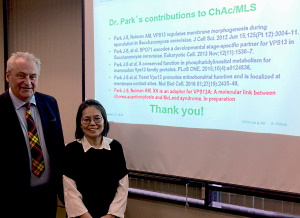 The Advisory Board of the Advocacy for Neuroacanthocytosis Patients is pleased to announce the first winner of the Glenn Irvine Prize is Dr. Jae-Sook Park from Dr. Aaron Neiman’s lab at Stony Brook, Long Island, NY, USA. The Advisory Board of the Advocacy for Neuroacanthocytosis Patients is pleased to announce the first winner of the Glenn Irvine Prize is Dr. Jae-Sook Park from Dr. Aaron Neiman’s lab at Stony Brook, Long Island, NY, USA.
Dr. Neiman’s nominating statement includes the following:
After receiving her Ph.D. from the University of Calgary, Dr. Park came to Dr. Neiman’s lab as a post-doctoral fellow; she now has the title of Senior Research Scientist. All of the studies that his lab has published on VPS13 are Dr. Park's work. Early in her time in his lab she performed a genetic screen that identified the yeast VPS13 gene as having a deficit in cytokinesis during spore formation. She helped to establish the current model of VPS13 as a contact site protein and reported the first potential link between mitochondrial dysfunction and chorea-acanthocytosis; she published two first author papers characterizing the role of VPS13 in sporulation in yeast and identifying the first VPS13 partner protein, Spo71. She also published a paper demonstrating that knockdown of VPS13A in PC12 cells produced similar effects on membrane lipids as seen in the yeast knockout cells. The work described in this last paper was made possible in part by a grant from the Advocacy.
Dr. Park is experienced with tissue culture and her knowledge of these methods has made it possible for his lab to move their experiments from the yeast system into human cells. In work which they hope to submit for publication, she has been extending the model of VPS13 function derived from studies in yeast to test predictions about the behaviour of VPS13A in human cell lines. Additionally, she has generated a large number of new point mutations in the yeast VPS13, many of which display loss of specific functions. Dr. Neiman’s lab is using these genetic tools to dissect which specific protein interactions and subcellular localizations are relevant to which activities of the VPS13 protein and hope to submit a paper describing these studies in 2020.
Dr. Neiman comments that Dr. Park is deeply committed to the VPS13 project. From the beginning she was motivated to focus on VPS13 by the possible relevance of the yeast studies to the human disease. As those connections have become clearer, she has only grown more dedicated to unravelling the VPS13 story. Dr. Neiman’s view is that the route to a treatment for neuroacanthocytosis begins with a detailed understanding of the molecular function(s) of the VPS13 protein. The contributions Dr. Park has already made provided great insight into how VPS13 proteins work. Going forward he fully expects Dr. Park to continue to make significant contributions to our understanding of how this protein family functions both in yeast and in human cells.
In addition to the above statement, Drs. Park and Neiman currently have a paper submitted which examines a relationship between VPS13A and XK, thus potentially illuminating the connection between chorea-acanthocytosis and McLeod syndrome.
Dr. Park will present a paper at the Barcelona Symposium in March next year when she will be presented with her prize.
 |  |
Campaign for Rare Disease Day 2020 is now underway
 The campaign for Rare Disease Day 2020 is now underway! The Rare Disease Day team at EURORDIS is building the campaign around ‘Reframe Rare’ – reframing what it means to be ‘rare’ to show that rare is many, rare is strong, rare is proud. The campaign for Rare Disease Day 2020 is now underway! The Rare Disease Day team at EURORDIS is building the campaign around ‘Reframe Rare’ – reframing what it means to be ‘rare’ to show that rare is many, rare is strong, rare is proud.
The campaign for Rare Disease Day 2020 is now underway! The Rare Disease Day team at EURORDIS is building the campaign around ‘Reframe Rare’ – reframing what it means to be ‘rare’ to show that rare is many, rare is strong, rare is proud.
You can find out more about Reframe Rare here. Anyone holding an event has been invited to post information about it. This means all of us can let others know about a planned coffee morning, a sponsored walk around the town or a swim in the local pool to raise funds for research into Neuroacanthocytosis. Whatever you do it does not have to occur on the 29th of February 2020 but should be in the name of Rare Disease Day.
There is lots of information and many examples of fundraising events from around the world on the Rare Disease Day website. When you have organised your event please send the details to Ginger at the Advocacy and it will be added to our site there. Thank you for being a part of Rare Disease Day and making a difference for people living with a rare disease.

 |  |
Neuroacanthocytosis Advocacy expands to the US
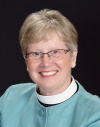 We are pleased to announce the founding of Neuroacanthocytosis Advocacy USA, Inc., a newly designated nonprofit organization dedicated to providing support to patients - and family and carers of patients - with neuroacanthocytosis-related diseases. We are pleased to announce the founding of Neuroacanthocytosis Advocacy USA, Inc., a newly designated nonprofit organization dedicated to providing support to patients - and family and carers of patients - with neuroacanthocytosis-related diseases.
 We are pleased to announce the founding of Neuroacanthocytosis Advocacy USA, Inc., a newly designated nonprofit organization dedicated to providing support to patients - and family and carers of patients - with neuroacanthocytosis-related diseases. We are pleased to announce the founding of Neuroacanthocytosis Advocacy USA, Inc., a newly designated nonprofit organization dedicated to providing support to patients - and family and carers of patients - with neuroacanthocytosis-related diseases.
The organization will also promote awareness of these ultra-rare diseases and actively support research. This is the first such organization in the United States and will be able to seek US-based grants.
Based in Florida, the organization's founding board members include a patient, family members of patients, and a researcher/physician.
They are Susan Wagner of South Carolina (top photo), Bob Metzger of Minnesota (middle photo), Dr. Ruth Walker of New York, and Joy Willard-Williford of Florida (bottom photo).
 Ginger Irvine is also on the board and provides a critical link to NA Advocacy. It is anticipated that the two organizations will work closely together to further each other's mission. Ginger Irvine is also on the board and provides a critical link to NA Advocacy. It is anticipated that the two organizations will work closely together to further each other's mission.
There is much work still to be done, including making an application to the Internal Revenue Service to be a 501(c)(3) organization, allowing donations to the organization to be tax-exempt. Stay tuned.

 |  |
Brain donation: Dr Ruth Walker on making an invaluable gift for NA research
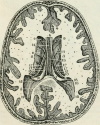 Many important advances in understanding brain diseases have been made by studying the brains of those affected. While imaging studies (MRIs and other types of brain scans) can give us important information about the brain during life, the examination of the brain tissue down the microscope after death can give us even more valuable information. These sorts of studies have led to major progress in brain diseases such as Parkinson’s and Alzheimer’s diseases, and are crucial in NA. Many important advances in understanding brain diseases have been made by studying the brains of those affected. While imaging studies (MRIs and other types of brain scans) can give us important information about the brain during life, the examination of the brain tissue down the microscope after death can give us even more valuable information. These sorts of studies have led to major progress in brain diseases such as Parkinson’s and Alzheimer’s diseases, and are crucial in NA.
 Many important advances in understanding brain diseases have been made by studying the brains of those affected. While imaging studies (MRIs and other types of brain scans) can give us important information about the brain during life, the examination of the brain tissue down the microscope after death can give us even more valuable information. In particular, we can find out how abnormal proteins, such as chorein in chorea-acanthocytosis (ChAc) and XK in McLeod syndrome, affect brain cells, what parts of the brain, which cells are most affected, and how brain chemistry changes. These sorts of studies have led to major progress in brain diseases such as Parkinson’s and Alzheimer’s diseases, and are crucial in NA. This is a way YOU can make an invaluable contribution to all those who suffer from NA, now and in the future. Many important advances in understanding brain diseases have been made by studying the brains of those affected. While imaging studies (MRIs and other types of brain scans) can give us important information about the brain during life, the examination of the brain tissue down the microscope after death can give us even more valuable information. In particular, we can find out how abnormal proteins, such as chorein in chorea-acanthocytosis (ChAc) and XK in McLeod syndrome, affect brain cells, what parts of the brain, which cells are most affected, and how brain chemistry changes. These sorts of studies have led to major progress in brain diseases such as Parkinson’s and Alzheimer’s diseases, and are crucial in NA. This is a way YOU can make an invaluable contribution to all those who suffer from NA, now and in the future.
Deciding to be brain donor is a personal decision that must be shaped by your feelings. This may be a difficult issue to consider, especially if you are trying to stay positive, and might be hard to discuss with those close to you. However, it might give you comfort to know that the search for medical knowledge will carry on, helped in no small part by your decision.
Glenn Irvine, one of the co-founders of Advocacy for Neuroacanthocytosis Patients donated his brain when he died in 2015. He carried one copy of the abnormal gene for chorein, although this did not give him any neurological problems. It will be fascinating to see if we find any changes in his brain as a result of this mutation.
How it works
If you decide that this is something that you would like to do, it is important to convey this decision to those involved in your care (specifically your close family members), and your physician. It is helpful to be evaluated periodically from time to time by your physician so that we can correlate your physical state with how your brain looks after death.
The neuropathology team at Mount Sinai in New York, led by Dr. John Crary is evaluating the brains of those affected by NA syndromes and those who are carriers of the genes. Regardless of where you live, if you wish to make this valuable donation, we will work with your local doctors to carry out your wishes. It is critical to make arrangements ahead of time, if at all possible, as brain tissue starts to change within minutes after death. While you are in good health you can fill out an “anatomical gift” form which clearly states your wishes, and your next-of-kin can sign the “autopsy permission” form, and send these to us. Having these forms on file ahead of time will help avoid delays when the time comes. The Advocacy for NA Patients can assist with transportation costs if necessary.
Frequently asked questions
Who can donate?
We encourage everyone to donate regardless of disease status. People who are unaffected are particularly important for comparison studies. Please reach out to us if you have questions.
Does it cost anything?
There is no cost to you for participation. Funeral arrangements will need to be made separately and your funeral home will need to pick up the body.
Will it affect my medical care?
No. Deciding to be a donor will never affect your care. But being part of this study will NOT impact your medical treatments, and may offer a sense of giving back hope to the NA community.
Will there be any disfigurement?
No. Being a donor will not prevent or delay the funeral service, either open or closed casket, cremation or burial.
Can I restrict the donation?
Yes. While NA affects the muscles, peripheral nerves, and other body tissues, the brain is the most important organ for us to examine, and donations can be restricted to the brain. Your decision is voluntary and can be revoked at any time. We will discuss and document in writing with you and your family any arrangements or restrictions you make to ensure your wishes are carried out as specified.
Does my faith permit it?
Most major religious traditions regard organ donation to help others as an act of charity. You may wish to discuss the subject with your religious advisor.
Will my family receive feedback?
Yes. Your family we receive a written report including a detailed explanation of the diseases that were identified at autopsy and the cause of death.
What’s the next step?
If you decide to participate, please share this decision with your loved ones to insure that your wishes are known and carried out. Please contact Dr. Ruth Walker and the Neuropathology Brain Bank team at Mount Sinai in New York, at brainbank@mountsinai.org now, in order to get more information and to make the appropriate plans. The forms noted above are also available here: “anatomical gift” form and “autopsy permission” form.
 |  |
NA Advocacy Board of Directors welcomes new members
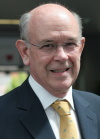 The Advocacy is delighted to welcome Dr. Peter Mills and Millie Leigh-Wood to our Board of Directors. We extend a very warm welcome and thanks to Peter and Millie for joining our Board. Read on for more details about each of our new Board members. The Advocacy is delighted to welcome Dr. Peter Mills and Millie Leigh-Wood to our Board of Directors. We extend a very warm welcome and thanks to Peter and Millie for joining our Board. Read on for more details about each of our new Board members.
The Advocacy is delighted to welcome Dr Peter Mills and Millie Leigh-Wood to our Board of Directors
 Born and raised in Scotland, Peter undertook preclinical studies and a year of research at Oxford University before graduating in medicine from St George’s Hospital, then at Hyde Park Corner, in 1971. Born and raised in Scotland, Peter undertook preclinical studies and a year of research at Oxford University before graduating in medicine from St George’s Hospital, then at Hyde Park Corner, in 1971.
After working at the Brompton Hospital and the National Hospital for Nervous Diseases Queen Square, he embarked on training in Cardiology at St George’s and then spent 2 years in Chapel Hill North Carolina, conducting research in cardiac ultrasound.
In 1979 Peter was appointed as a consultant cardiologist at the Royal London Hospital, subsequently also working at the London Chest Hospital in a specialist cardiac unit. He retired from active practice in 2014.
Peter published 95 scientific papers on a variety of subjects including cardiac ultrasound, valve disease, coronary artery disease and the underline principles of postgraduate training. He was Chairman of the committee which supervises Training in Cardiology in the UK and subsequently developed this interest within the European context.
Latterly in his clinical work, he developed an interest in diseases of the heart muscle. This in some cases heart muscle disease is associated with abnormalities of skeletal muscle – muscular dystrophies, and hence he encountered patients with both mild and severe forms of neuromuscular disorders. This explains, using the modern parlance, the “journey” of a clinical cardiologist steeped in the macho nature of the specialty, to an appreciation and understanding of the varied disabilities associated with these disorders and the profound effects of these disabilities on both patients and carers.
 Millie Leigh-Wood was brought up in London and Norfolk and graduated from Newcastle University with a BA Hons degree in Combined Studies of Russian History and Philosophy. Periods of charity work in India and Mexico fuelled her passion to care for people and Millie then trained as a nurse at Thames Valley University. Millie Leigh-Wood was brought up in London and Norfolk and graduated from Newcastle University with a BA Hons degree in Combined Studies of Russian History and Philosophy. Periods of charity work in India and Mexico fuelled her passion to care for people and Millie then trained as a nurse at Thames Valley University.
After beginning her career as an oncology nurse at University College Hospital in London, Millie has worked in a range of institutions including the NHS, private healthcare, the charity sector and the insurance industry. Improving patient safety and raising standards of care have always been the driving forces for the different roles that she has undertaken. Whilst working as Senior Caseworker and then Deputy Chief Executive of the healthcare charity, The Patients Association, Millie wrote a paper examining the work of the Parliamentary and Health Service Ombudsman which was reviewed by the national press.
She has worked as a consultant in clinical governance and risk management in a number of NHS Trusts and most recently as part of the medical malpractice team of the international insurance company, CNA Hardy. She continues to deliver her healthcare risk analysis expertise and this year has returned to clinical nursing at Royal Trinity Hospice.
We extend a very warm welcome and thanks to Peter and Millie for joining our Board.
 |  |
RESEARCH UPDATE - Adrian Danek and Gabriel Miltenberger-Miltenyi , Munich
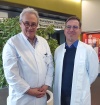 Learn about the recent progress of NA researchers around the world who are investigating the causes, mechanisms and pathology of the NA group of diseases. Learn about the recent progress of NA researchers around the world who are investigating the causes, mechanisms and pathology of the NA group of diseases.
Adrian Danek and Gabriel Miltenberger-Miltenyi
University of Munich

The team in Munich (Adrian Danek and Gabriel Miltenberger-Miltenyi) achieved some important insights into ChAc patient care: they started the re-vitalization of the chorein blot diagnosis and soon this will be offered again for patients world-wide.
Also, they initiated the exome-wide genetic characterization of ChAc patients from the patient cohort in Munich. In addition, together with Antonio Velayos-Baeza, they started the set-up of a human mutation database for the VPS13A gene, that will be integrated into the open-access Leiden Open Variation Database and into the NIH-linked ClinVar/ClinGen mutation database. These sources are widely used by physicians diagnosing patients with ChAc, thus our initiative will support these colleagues in the correct interpretation of VPS13A mutations. These milestones were achieved through the generous donation of seed money by Betty and Carl Pforzheimer to the Advocacy, in honour and in memory of Glenn Irvine.
As a part of scientific investigation projects, they initiated the elaboration of a zebrafish model of ChAc in Munich.
In collaboration with the LMU Department of Nuclear Medicine in Munich, they examined microglial activation in the brain of McLeod's patients (from Munich) and ChAc patients (from Dresden). Results of this study will help to analyse ongoing central nervous system processes in these NA syndromes.
Additionally, they set up a collaboration with Saarland University, for the biophysical-biochemical characterization of erythrocytes in ChAc on samples from Munich and from Dresden. Pilot results are will be presented at the 10th NA Symposium, in Barcelona March 25-27 2020.
 |  |
Neuroacanthocytosis Webinar now available for viewing
 Within the educational programme of the European Reference Network-Rare Neurological Diseases (ERN-RD) a webinar on Neuroacanthocytosis syndromes took place on 3 December. Adrian Danek from Ludwig-Maximilians-Universität in Munich, Germany, presented an overview mainly of Chorea-Acanthocytosis and of McLeod syndrome. His presentation is now available. Within the educational programme of the European Reference Network-Rare Neurological Diseases (ERN-RD) a webinar on Neuroacanthocytosis syndromes took place on 3 December. Adrian Danek from Ludwig-Maximilians-Universität in Munich, Germany, presented an overview mainly of Chorea-Acanthocytosis and of McLeod syndrome. His presentation is now available.
Is DBS right for you? Ruth Walker explains
 In this edition of NA News, patient Drew Smith reports on the positive outcome he has experienced following his deep brain stimulation (DBS) surgery. The videos of him performing various athletic activities are indeed impressive! His situation has also been recently reported in the medical literature (Richard et al, Efficacy of Deep Brain Stimulation in a Patient with Genetically Confirmed Chorea-Acanthocytosis https://www.ncbi.nlm.nih.gov/pmc/articles/PMC6738267/ . 2019 May-Aug; 11(2): 199–204). In this edition of NA News, patient Drew Smith reports on the positive outcome he has experienced following his deep brain stimulation (DBS) surgery. The videos of him performing various athletic activities are indeed impressive! His situation has also been recently reported in the medical literature (Richard et al, Efficacy of Deep Brain Stimulation in a Patient with Genetically Confirmed Chorea-Acanthocytosis https://www.ncbi.nlm.nih.gov/pmc/articles/PMC6738267/ . 2019 May-Aug; 11(2): 199–204).
It is important for everyone affected by neuroacanthocytosis to be aware that the benefits which Drew has experienced are most likely due to a number of specific factors, and may not apply to other people affected by chorea-acanthocytosis or McLeod syndrome.
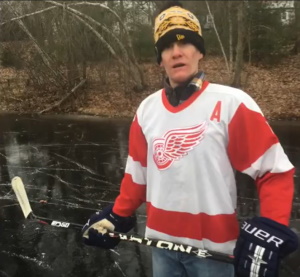 In this edition of NA News Drew Smith reports on the positive outcome he has experienced following his deep brain stimulation (DBS) surgery. The videos of him performing various athletic activities are indeed impressive! His situation has also been recently reported in the medical literature (Richard et al, Efficacy of Deep Brain Stimulation in a Patient with Genetically Confirmed Chorea-Acanthocytosis. 2019 May-Aug; 11(2): 199–204). In this edition of NA News Drew Smith reports on the positive outcome he has experienced following his deep brain stimulation (DBS) surgery. The videos of him performing various athletic activities are indeed impressive! His situation has also been recently reported in the medical literature (Richard et al, Efficacy of Deep Brain Stimulation in a Patient with Genetically Confirmed Chorea-Acanthocytosis. 2019 May-Aug; 11(2): 199–204).
It is important for everyone affected by neuroacanthocytosis to be aware that the benefits which Drew has experienced are most likely due to a number of specific factors, and may not apply to other people affected by chorea-acanthocytosis or McLeod syndrome.
DBS involves the permanent implantation of electrodes into the brain, which is done through holes in the skull. Leads are tunnelled underneath the skin and connect the electrodes to a battery unit which is typically implanted underneath the skin on the upper chest. Usually, one electrode is implanted on each side of the brain. The hardware is all underneath the skin, and it does not limit people with DBS from showering or swimming. The procedure is normally carried out in 2-3 separate operations. Following the implantation, the system needs to be programmed. This can be a lengthy process and require a number of appointments over a few months to try out different electrical settings in order to determine which are the most beneficial.
DBS has been used in a number of other neurological conditions which result in movement disorders. DBS has been used since the 1990’s for Parkinson’s disease (even though this is a quite different type of movement disorder, where movements are too slow and small); sometimes different brain structures are targeted for different types of movement problems. We are slowly learning, mainly through trial and error, about the other types of neurological (and even psychiatric!) disorders which can benefit from DBS.
Unfortunately, DBS can only help control specific symptoms of NA, and there is no evidence that it changes the underlying brain process. When considering whether DBS will be helpful, we should identify which are the symptoms which are being targeted - DBS can only help the excessive involuntary movements – known as chorea or dystonia. In NA these can affect the face, tongue, trunk, and limbs. If there is benefit, it may be possible to reduce the doses of any medications being taken to control the movements.
While DBS is quite straightforward and relatively low-risk as brain surgery goes, no-one should undergo the DBS implantation unless they can fully understand the risks, and how the process works. It is critical to have realistic expectations of what DBS can and can’t do. If someone has significant problems with thinking and memory and can get confused and disoriented, DBS is not the best thing to do to their brain. The electrodes which are implanted are small, but there is a risk of a small amount of damage being done to the frontal lobes, which can result in a worsening of confusion. Typically, a formal evaluation of thinking and memory (neuropsychological testing) is recommended before someone goes forward with the process.
Another factor to bear in mind is that the symptoms of NA can change with time – and in some cases the involuntary movements go away by themselves. This means that the effects of DBS should be evaluated probably every year, to determine whether it is still helpful. We don’t yet know enough about how long DBS can be beneficial for in NA.
So, in conclusion, I would like to thank Drew for reporting on the exciting positive effects he experienced with DBS - and I hope that he keeps us updated on his progress. For those who are trying to decide whether DBS is right for them, they should discuss it in detail with their neurologist, and make sure they are working with someone who has a lot of experience with this procedure. DBS is not a cure-all, and we are still in the process of learning about its role in managing NA, but it can play a useful role in controlling certain problems with movements
 |  |
German clinic launches NA website for patients
We were delighted to receive the news from Kevin Peikert in Rostock, Germany about their new website.
"We have just set up a Neuroacanthocytosis website for our new outpatient clinic," Kevin writes. "It features information about NA and NBIA with various subdivisions; the first page introduces their specialist consultations and there are other pages relevant to the two illness groups generally, sometimes in connection with specific mentions of the Rostock facility."

You can find the website here or click the image above.
FUNDRAISING - Gill and Gordon Parry
 We have heard very recently from Gill and Gordon Parry in north Wales who have again produced impressive funds for the Advocacy. Gill wrote: We have heard very recently from Gill and Gordon Parry in north Wales who have again produced impressive funds for the Advocacy. Gill wrote:
"I wanted you to know that we had a Craft Fayre in the local Tithe Barn and we had the best sale of work yet. We took £1,119 in a few hours. We still can't believe it. The preparation is quite challenging but it has been so worthwhile. Local support is tremendous.”
Thank you once again Gill and Gordon!
Concert and raffle raises funds for NA research
 On July 13, 2019, Tracy Ghoris from Ohio held a benefit concert and basket raffle at Mount de Chantal Conservatory of Music at Wheeling University, West Virginia, raising $1,043.00 USD for Neuroacanthocytosis research. A good time was had by all. On July 13, 2019, Tracy Ghoris from Ohio held a benefit concert and basket raffle at Mount de Chantal Conservatory of Music at Wheeling University, West Virginia, raising $1,043.00 USD for Neuroacanthocytosis research. A good time was had by all.
On July 13, 2019, Tracy Ghoris from Ohio held a benefit concert and basket raffle at Mount de Chantal Conservatory of Music at Wheeling University, West Virginia, raising $1,043.00 USD for Neuroacanthocytosis research. A good time was had by all.
Bill Forrest from Colorado, a very talented pianist and vocalist who has performed on cruise lines for over 20 years, entertained 36 of Tracy's friends and family members with classical, jazz, Ragtime, standard, and pop music. The audience really enjoyed Bill's great performance. Light refreshments were also served.
 Eleven themed baskets/containers filled with wonderful items were raffled off. Ohio basket weaver Susie Rataiczak (a friend of Tracy's since childhood) donated a lovely basket filled with dog treats and toys donated by Pawz in Time. West Virginia pottery maker Winnie Hurd donated a gorgeous bowl with goodies. Tracy's dad donated several items from his former shop, while a few local stores and restaurants donated items as well. Eleven themed baskets/containers filled with wonderful items were raffled off. Ohio basket weaver Susie Rataiczak (a friend of Tracy's since childhood) donated a lovely basket filled with dog treats and toys donated by Pawz in Time. West Virginia pottery maker Winnie Hurd donated a gorgeous bowl with goodies. Tracy's dad donated several items from his former shop, while a few local stores and restaurants donated items as well.
Tracy's mom served as event treasurer, and Jane Keyser (a neighbor and lifelong friend of Tracy's) helped assemble baskets/containers and sell raffle tickets.
Thank you everyone who helped with and attended this successful fundraiser that raised funds for an important cause.

 |  |
PATIENT NEWS - Drew Smith ¦ Nidia Santiago
 Read a selection of updates from NA patients around the world. Read a selection of updates from NA patients around the world.
1. Drew Smith, US
We have heard recently from patient Drew Smith, about his experiences of Deep Brain Stimulation.
 "Last summer I moved back home to Lexington to be closer to doctors. In October I had Deep Brain Stimulation DBS surgery. Doctors have been following me closely and have publications coming out soon. DBS is mostly for tremors, dystonia and Parkinson's patients- pretty interesting stuff! "Last summer I moved back home to Lexington to be closer to doctors. In October I had Deep Brain Stimulation DBS surgery. Doctors have been following me closely and have publications coming out soon. DBS is mostly for tremors, dystonia and Parkinson's patients- pretty interesting stuff!
"I feel better, look better and am doing a lot better than last summer. It's been a roller coaster of a year but good! I am staying active, running, boxing skating and golfing which I struggled last summer and spring at! I could not sit still, but now I can! Unfortunately, I am not teaching because of my health but staying active has been my job.
"I recently had a feeding tube put in. While my swallowing is good I am not great at keeping the food in. I am not gaining weight but losing weight. The way l see it, if I can gain weight through a feeding tube, it may help with my movements and help with DBS. Still will be able to eat and drink. This will alleviate stress, weakness and beef me up?!"
Ruth Walker has offered this commentary on Drew's article elsewhere in NA News.
2. Nidia Santiago, Puerto Rico

"I share with you a photo of Nidia and our three daughters in our most recent visit to the Ponce Art Museum."
"In Puerto Rico it is warm as always. We hope your winter is not too cold. Nidia's condition has continued to evolve as is natural in her illness. We keep adapting continuously to enjoy being together as a family. Although it is increasingly difficult for Nidia to communicate with her tablet, she continues to contribute with her opinions and advice to our marriage and to the education of our daughters."
"Over time we have learned to value and enjoy the daily moments of everyday life and to thank God for each one of them. In our case, the experience with God that we shared from youth, has been the key to face the challenges of Nidia's illness and to be able to educate and guide our daughters, now 14, 20 and 21 years old."
"We sincerely appreciate the efforts of NA Advocacy for your commitment and dedication to support and guide those who, as part of our lives, face the challenge of living with this disease. Thank you for everything and to continue your efforts, you will always be in our prayers."
"I appreciate your communication because by writing me it allowed me to resume contact with Eliut and Vivian, whom I called, after your first email. Nidia was having some major problems to be able to eat and at risk of perspiration, which put Nidia's health at risk. When I spoke with Eliut it turned out that Vivian had gone through the same problem and in an occasion when eating she transpired and had a respiratory arrest, but she is ok now. After Eliut and Vivian visited us, it helps us to Nidia accept the need to attend to her condition and the medical recommendation for a long time. Almost one month ago Nidia was operated to place a PEG and be able to eat properly. It has not been easy for Nidia or for us; but it has helped us reduce the risk at eating and ensure a more adequate diet. As you can see, your commitment and emails make a lot of difference. Thanks!"
 |  |
In Memoriam: Heidi Nicole DiMarzio
 We were sad to receive news of the death of NA patient Heidi Nicole DiMarzio. Her family sent us this tribute: We were sad to receive news of the death of NA patient Heidi Nicole DiMarzio. Her family sent us this tribute:
Heidi was born on November 14, 1978 to Vince and Candi DiMarzio. She attended Shenandoah University, James Madison University, and Northern Virginia Community College, where she was chosen to intern at the United States Capitol for West Virginia Congressman Alan Mollohan. At JMU, she was a member of the Catholic Church and was a Eucharistic Minister, and became secretary of the JMU College Democrats. Her passion for politics is what drove her to earn a Bachelor of Science in Political Science and she graduated in 2002.
We were sad to receive news of the death of NA patient Heidi Nicole DiMarzio. Her family sent us this tribute:
 Heidi was born on November 14, 1978 to Vince and Candi DiMarzio. She attended Shenandoah University, James Madison University, and Northern Virginia Community College, where she was chosen to intern at the United States Capitol for West Virginia Congressman Alan Mollohan. At JMU, she was a member of the Catholic Church and was a Eucharistic Minister, and became secretary of the JMU College Democrats. Her passion for politics is what drove her to earn a Bachelor of Science in Political Science and she graduated in 2002. Heidi was born on November 14, 1978 to Vince and Candi DiMarzio. She attended Shenandoah University, James Madison University, and Northern Virginia Community College, where she was chosen to intern at the United States Capitol for West Virginia Congressman Alan Mollohan. At JMU, she was a member of the Catholic Church and was a Eucharistic Minister, and became secretary of the JMU College Democrats. Her passion for politics is what drove her to earn a Bachelor of Science in Political Science and she graduated in 2002.
In 2004, Heidi met Kevin and they were married on October 28, 2006 on a lovely fall day that started off a little misty. As the clouds rolled through from a late rain, a beautiful rainbow appeared behind them in the sunroom at the very same moment they were saying their “I Do’s.” It was a beautiful, memorable moment.
Heidi was a big fan of music and cooking and Heidi and Kevin loved traveling together. Every weekend they had some sort of trip planned, whether it be a museum in Washington, DC or a trip a couple hours away to sightsee in Virginia. They traveled to Europe when they were dating, honeymooned in Hawaii and went to London for Christmas in 2014. The following year they went to Australia and spent New Year’s Eve there. Soon after her official diagnosis, they spent 2 weeks in Greece. Their last big trip was to South Africa. The smiles on their faces from the photos are something to cherish forever. It brings us comfort knowing she was able to see so much of the world.
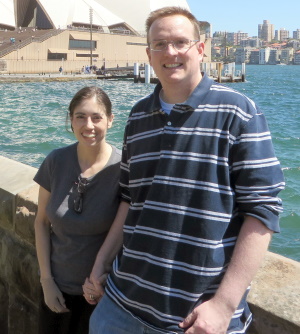 Heidi was the best aunt to her nephews, Jayden and Alexander. She spoiled them so much and continue to be a big presence in their lives. Just days before she passed away, she attended Jayden’s all-star soccer tournament. She was so proud of him and Jayden was thrilled to see his Aunt Heidi and Uncle Kevin there. Aunt Heidi will always remain in their lives and will know all about her through stories and photos. Heidi was the best aunt to her nephews, Jayden and Alexander. She spoiled them so much and continue to be a big presence in their lives. Just days before she passed away, she attended Jayden’s all-star soccer tournament. She was so proud of him and Jayden was thrilled to see his Aunt Heidi and Uncle Kevin there. Aunt Heidi will always remain in their lives and will know all about her through stories and photos.
At the end, Heidi’s life was hard but she was determined to leave this world on her own terms and to keep her dignity. She was rarely photographed in her wheelchair and would often lean up against an object so she wouldn’t fall. It’s not that she was embarrassed to be in a wheelchair, just the opposite. She didn’t care what people thought of her when she was out and about but, much like this tribute, she didn’t want her physical struggles to overshadow who she was. She most certainly should have been using a feeding tube for nutrition (as many NA patients do), but she refused. There was a risk of her aspirating to death but she was willing to take that risk so she could live her life as she wanted.
She planned her funeral and what she wanted to be said. She picked her favorite song to be played at the funeral. She left us far too soon but in her short 40 years on this earth, she showed us courage, strength, humor, and a desire to be her; unapologetically Heidi.
 |
|
|
|